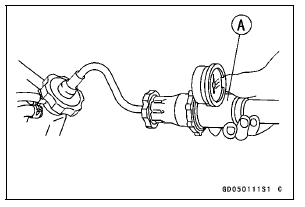

Remove the radiator cap in two steps. First turn the cap counterclockwise to the first stop. Then push and turn it further in the same direction and remove the cap.

NOTE
Wet the cap sealing surfaces with water or coolant to prevent pressure leaks.

NOTICE
During pressure testing, do not exceed the pressure for which the system is designed. The maximum pressure is 142 kPa (1.45 kgf/cm², 21 psi).
If the pressure holds steady, the system is all right.
If the pressure drops and no external source is found, check for internal leaks. Droplets in the engine oil indicate internal leakage. Check the cylinder head gasket and the water pump.
Remove the pressure tester, replenish the coolant, and install the radiator cap.
 Coolant Deterioration Inspection
Coolant Deterioration Inspection Cooling System Flushing
Cooling System FlushingAir Cleaner Element Replacement
NOTE
In dusty areas, the element should be replaced more
frequently than the recommended interval.
WARNINGIf dirt or dust is allowed to pass through
into the
throttle body assy, the throttle may become stuck,
possibly causing accident. Replace the air cleaner
element according ...
Crankcase Assembly
NOTICE
The upper and lower crankcase halves are machined
at the factory in the assembled state, so the
crankcase halves must be replaced as a set.
With a high flash-point solvent, clean off the mating surfaces
of the crankcase halves and wipe dry
WARNINGGasoline and low flash-poin ...
Front Fender Removal
Remove:
Bolts [A] with Washers (Both Sides)
Reflectors (Both Sides, US, CA, CAL and AU Models)
Front Fender [B]
Take the brake hose off the clamp [C] (both sides).
Front Fender Installation
Apply a non-permanent locking agent to the front fender
mounting bolts.
Tighten:
...